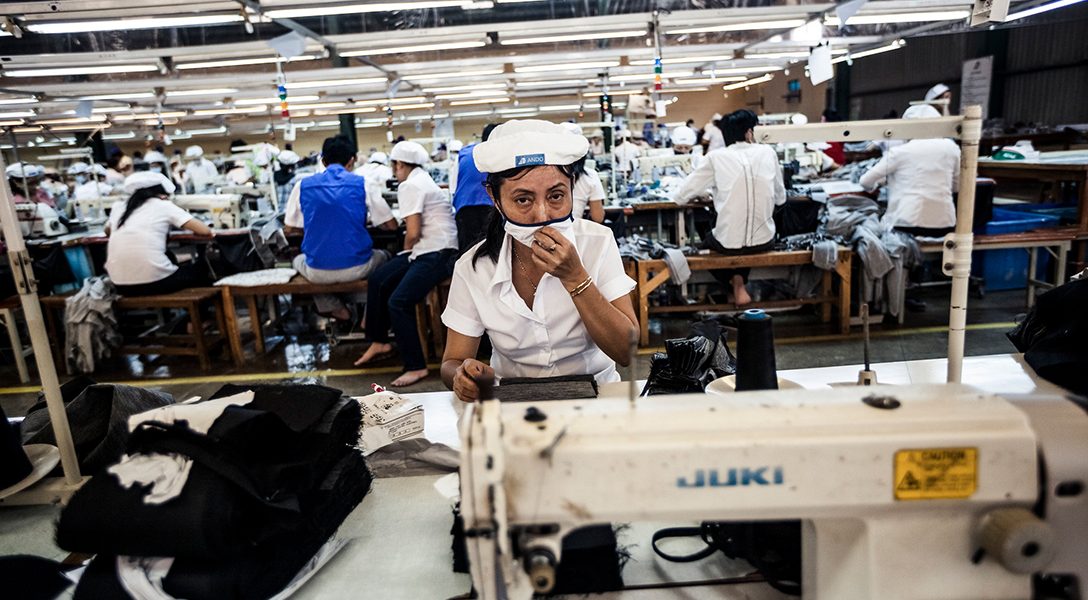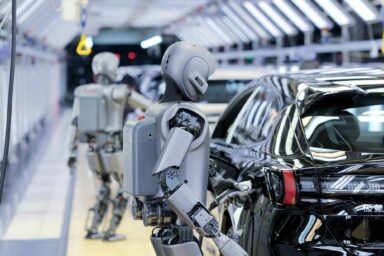As millions of Americans are hunting for the latest fashion bargains on Black Friday, we take a look at the social and environmental damage that our clothes are doing to the planet.
On this Black Friday, we’re looking at the dark side of shopping. Specifically, clothes and the fashion industry. In this week’s WhoWhatWhy podcast, we talk with longtime fashion and style journalist Dana Thomas about how clothes are rapidly becoming the new plastic.
She lays out the problem succinctly: there are far too many clothes in the world, they are produced in horrible working conditions, and even retailers generally have no idea where their products are made.
Thomas points out that there are over one hundred billion pieces of clothing manufactured each year and only eighty billion are ever sold. The rest are burned or end up in the world’s landfills. Moreover, the synthetic fabric of most clothes is plastic-based and nonbiodegradable; some plastic microfibers have even been found in rainfall around the world.
In order to produce today’s extremely cheap, disposable clothing, the supply chain is so fractured that even an item that says “Made in Italy” may have had only the buttons sewn on there, while the garment may have been manufactured in a sweatshop in Bangladesh.
Thomas explains how and why we are paying below-market prices for clothes, and why the real push for change must come from consumers.
The good news, Thomas says, is that millennials are beginning to exhibit a greater sense of social responsibility in the clothes they buy, and, as a result, manufacturers are looking at everything from new “bio-fabrics” to automation in an effort to better serve both people and the planet.
Click HERE to Download Mp3
Full Text Transcript:
As a service to our readers, we provide transcripts with our podcasts. We try to ensure that these transcripts do not include errors. However, due to time constraints, we are not always able to proofread them as closely as we would like. Should you spot any errors, we’d be grateful if you would notify us.
| Jeff Schechtman: | Welcome to the WhoWhatWhy podcast. I’m your host, Jeff Schechtman.
No matter who we are, we are touched by food, shelter, and clothing. Of the three, perhaps clothing is the one we most take for granted. Unlike our food, we don’t usually think about where it comes from. Unlike shelter, it’s an abundance and unlike these other necessities, the price keeps falling while the style keeps improving. It’s almost too good to be true and maybe it is. |
| Jeff Schechtman: | In fact, there is a darker side, a steeper price to be paid by both consumers and society for the proliferation of inexpensive fashion. As you shop this Black Friday, it’s worth noting that there’s also a morality to what you wear. We’re going to talk about that with my guest, Dana Thomas. She’s a bestselling author and longtime fashion and style journalist. She began her career writing for the style section of the Washington Post and has served as a cultural and fashion correspondent for Newsweek in Paris and a contributor to the New York Times style section. Her most recent look at the fashion industry is entitled Fashionopolis. It is my pleasure to welcome Dana Thomas here to the WhoWhatWhy podcast. Dana, thanks so much for joining us. |
| Dana Thomas: | My pleasure. Anytime you want. I love speaking with you. |
| Jeff Schechtman: | Well, it’s a delight to have you here. The business of fashion, what used to be called the garment business, has been around for a long time. I remember even as a kid, racks of clothes going down the streets of the West side in New York. Talk a little bit about what’s different. When did it change to the business that it is today? |
| Dana Thomas: | It changed to the business today about 30 years ago. Though, mind you, this is how the business started 250 years ago in Manchester, when Manchester was called Cottonopolis. It remained that way until pretty much the 1930s when we had wonderful Florence Perkins as our labor secretary, the first woman and the longest serving secretary in the cabinet. She ushered through many great reforms during the New Deal, including the Fair Labor Act and giving us things like the 40-hour work week and paid vacation. So because of her, we entered a golden age of manufacturing in America where you had garment rags wheeling down the West side of New York City. |
| Dana Thomas: | Before that, we had sweatshops in New York City, just like we have sweatshops in Bangladesh. There was a great crusader in the late 19th century named Florence Kelley who introduced something called the White Tag that was to be affixed to clothes that had not been made in sweatshops so consumers would know. It’s basically like a Good Housekeeping Seal of Approval. We don’t have that anymore. We could surely use it, because we just don’t know. |
| Jeff Schechtman: | And what we have today is a proliferation of clothing made all over the world, manufactured inexpensively, in some cases, manufacturers looking for the least expensive place to manufacture it. Talk a little bit about that, the world today. |
| Dana Thomas: | Absolutely. It really did shift after NAFTA. That was the turning point. There are a lot of people, economists and trade specialists who will tell you, “No, no, it’s not true.” You go and talk to the workers in the factories and they’ll say, “Before NAFTA, I had a job and after NAFTA I didn’t have a job. My town didn’t have jobs. Our town went into a serious depression and recession and we lost everything.” So, NAFTA was a turning point. It didn’t … the numbers didn’t quite equal as Ross Perot suggested they would, but there was definitely that sucking sound of jobs to Mexico as he described it. Then from Mexico, they went to the Far East. |
| Dana Thomas: | Today, our clothes, it’s a fractured supply chain that is all around the world. Even if it says it’s Made in Italy, it could have been made in Bangladesh and just had the buttons sewed on in Italy and it gets that label. It’s a very opaque supply chain. Many companies don’t even know where their clothes are made. As we witnessed when the Rana Plaza factory collapsed five years ago and more than 1,200 people were killed in this shoddy factory that they’ve thrown up and without adhering to building standards and zoning standards. There were brands in there that said, “We had no idea our clothes were being made there.” or “We never contracted those people to make there, that they’d been subcontracted and subcontracted and they’ve lost track of where their clothes were being made.” So, if they don’t know, how are we supposed to know? It’s a very tricky business. |
| Jeff Schechtman: | Why should it matter to consumers today? |
| Dana Thomas: | Well, it should matter to consumers. Well, with Rana Plaza, I mean quite simply two weeks later the clothes that those poor folks who were crushed in that building were sewing were on store floors and you bought them and you had no idea that the next day that person was squashed underneath beams and cement or bedridden for life. So, we should care because it’s about humanity and the planet that the impact of the fashion industry is enormous on the environment. We produce 100 billion garments a year. We only buy 80 billion. That leaves 20 billion leftover that are going, where? Okay? Just stop and think for a minute. Where are they going? They’re getting burned. They’re getting shredded, they’re getting thrown in landfill. Our landfills are heaving with clothes, clothes that are made of polyester, which is essentially plastic and does not biodegrade. |
| Dana Thomas: | We have now … we have discovered in the last few years that polyester emits microfibers into our water system and is now being eaten by fish, which we eat. It’s now being found in the ice of Antarctica. Last week, I read it’s raining plastic microfibers in the Rockies. So, you can have an organic garden in Boulder, Colorado, but it’s being covered in plastic rain. So, consumers should care because we have too many clothes. They’re being made in horrible conditions. Not always, but a lot by people who can’t afford to house and clothe and feed their families because it’s below living wage. We think we’re giving them good jobs. They are not good jobs. I’ve been there and visited them. The economic impact is immeasurable. We need to change our ways as consumers and we need to basically bully companies into greener practices. |
| Jeff Schechtman: | Of course, that also, some would argue, means more expensive clothing than we have now. |
| Dana Thomas: | Clothing has never been so cheap. We don’t realize how cheap it is. I kept hearing this and reading this when I was working on the book. Clothes have never been so cheap. I was like, “What does this mean?” Then I had this aha moment where it just became very clear. I was reading an article in the New Yorker from 1940 by this wonderful writer named Lois Long about Hattie Carnegie, the marvelous retailer of New York in the 1920s and 30s. Her clients were the super-rich women like Mrs. Harrison Williams, who was the wife of the richest man in America, or Joan Crawford, that sort of select few, and they were buying remakes of Paris originals in her shop. Authorized remakes, that’s how it was done then. They bought the patterns and then they made them in the shop. Those women were paying between $803,000 for those gowns exactly what you pay today at Prada, Gucci and Chanel. So, okay. Right. Those prices of clothes have stayed the same. |
| Dana Thomas: | Then during the height of the depression, when the stock market crashed, Hattie Carnegie came up with the idea of coming out with a middle market consumer line to keep the money coming in because many of her big … her wealthy clients lost their fortunes. It was called spectator sport. Raymond Chandler, the writer, called it ‘the secretary special’, which I think really describes it wonderfully well. So, a secretary could go in and buy it and wear a good … this lovely little suit from Hattie Carnegie and dress it up with a broach or wear it with a sweater one day and a blouse with another. You know how much that suit cost? About 19.99 exactly what we’re paying today in H&M or Topshop or Zara. Not adjusted for inflation prices, not real prices then versus now la, la, la. Exactly the same price. |
| Dana Thomas: | When the price of ground beef has gone up, how much? When the cost of a taxi cab ride has gone up, how much? When the cost of a gallon of gasoline has gone up, how much? We’re paying the same price for clothes. So, that gives you an idea of how, while we say we can’t afford it or the good clothes are expensive, in fact, we’re paying so below market we don’t realize it. We buy 10 of them instead of one of them. Maybe we need to go back to the other model where we spent $200 on one item, then $20 for 10 on each of 10 items. |
| Jeff Schechtman: | Talk a little bit about that because that is an idea that comes into its own fashion every once in a while, that people should spend more money on better quality and buy less items and it always seems to be a fad that lasts for a while and then it seems to fade away. |
| Dana Thomas: | Well, I think we need to do it now simply because we are awash in clothes. We just have no place to put all the leftover clothes. When we pay $200 for something, be it a garment, be it at anything, we are investing in it and we’re investing not just money but also emotion. We’re caring for it. We’re less cavalier with it. When we pay 20 bucks for it, we’re like, “Ah, I spilled some mustard on it or some sunscreen on it and I can’t get it out, whatever. I’m just going to toss it.” As opposed to it costs more to take it to the dry cleaners and get it cleaned than it would to replace it. I’ll just throw it away and buy another one. Instead of actually investing in it and cherishing it and saying, “Oh, I should take it to the dry cleaners and get it cleaned because it cost 200 bucks and I don’t want to spend another 200 bucks replacing it.” |
| Dana Thomas: | There’s that idea that they’re throw-away clothes. Throw-away clothes is a horrible idea just like throw- away anything is a horrible idea, because the thrown- away goes somewhere. It doesn’t just evaporate. It’s like … I’ve always laughed at smokers who fling cigarettes out the window as if it just disappears into the air and then you’re standing two floors below and it lands at your feet and you’re like, “Yoho, there’s somebody down here.” So, it’s the same thing with clothes. You throw it in the trash, it goes somewhere and we have to realize that it’s going into landfills that are getting too full, and it’s polyester that doesn’t break down. It doesn’t biodegrade, so it lasts forever because polyester is essentially plastic and then it breaks down or the chemicals go into our water table and poison the water table. There’s a much bigger impact than we realize when we just tossed that garment because it cost nothing, and it would cost more to clean it than it would to replace it. |
| Jeff Schechtman: | How much of this is driven by fashion and styles, specifically that things go out of style, they become less trendy, therefore you want to get rid of them and buy something new and more current? |
| Dana Thomas: | Well, some of this is driven by the fast fashion companies and by the fashion industry itself, which is on a speedy, speedy cycle that’s just going so fast. I mean every time you blink there’s another fashion week. Things are coming and going and they’re … I wrote a book before this called Gods and Kings about Alexander McQueen and John Galliano. John Galliano when he started his company and he put out two collections a year. By the time he left Christian Dior sort of 15 or 20 years later, he was overseeing 32 collections a year. So, that just shows you how much the speed has come up and the offerings, how we just have to have new, new, new, new, new. That’s because of the Zara model, which was always dropping new items on the store floor every week to beg consumers into buy more. |
| Dana Thomas: | Before we used to go to stores four or five times a year and Zara, because of the changing of what’s on the floor, the inventory and how it’s being updated all the time, they averaged 17 times a year, therefore we’re burning through styles really quickly and trends really quickly. Then the influencers especially on Instagram are speeding this up because they only wear things once or twice and then it’s not seen again. They’re like, “Okay, that’s out and this is in and that’s out and this is in and that’s out and this is in.” So, it’s all going just really, really fast. It’s like being on a merry-go-round that’s just speeding around so fast. It’s making us dizzy and flinging people off along the way. |
| Dana Thomas: | My two favorite influencers right now are Kate Middleton and Meghan Markle because they’ve introduced what I’m calling ‘the royal re-wear’ where they just keep trotting out the same clothes over and over again for super high profile events, and the fashion chroniclers of the royals note this. Kate has this Alexander McQueen pine green coat that she’s worn several times to several major events. She’ll wear it to the Trooping of the Color, then she’ll wear it to the Queen’s birthday and then she’ll wear it to a wedding, and she wears it with a broach or she changes it for a different hat. It might come out of the state visit. She wears it just from the car to the … you see it all the time. What she’s telling us is that I paid a lot for this outfit, this coat. I love this coat. This coat looks good on me. Why should I toss it? I’m going to keep wearing it because I’m investing emotion. I’m cherishing this coat and it’s okay to do that. It’s sexy to do that. It’s admirable to do that and I’m going to do it. I’m someone who can afford to change my clothes with every time I step out the door. |
| Jeff Schechtman: | How much of the change that we’re seeing is generational? |
| Dana Thomas: | A lot of it is generational. The millennials are pushing this because they are so green-oriented. They understand the impact of climate change. They’re worried. They’re worried. Let’s be frank. They’re worried. So, they really … whether it’s farm to table movement, whether it’s recycling, whether the complete demonization of the plastic straw that happened in the last 18 months or two years, the millennials are a force and they’re changing things for the good. They’re definitely behind a lot of the change that’s coming, which is great. They’re demanding it of companies. They’re demanding companies to be more environmentally aware and more concerned about human rights. |
| Jeff Schechtman: | What is the nexus, if any, between these changes in what’s going on with clothes and the fashion industry and the corresponding changes we see taking place in the retail landscape? |
| Dana Thomas: | Well, the retail landscape is really interesting. Malls are dying left and right. There’s actually a crazy YouTube channel called The Death Mall Tour, I think, where you can see this guy going and visiting all these malls, these abandoned malls throughout the United States. That’s in part because now we order everything online and not just Amazon, but online from everywhere. This has allowed startups though to decentralize from the New York, Paris, Milan grid. Big cities, Chicago, LA, and be based anywhere, which means that they’re … the price for running their company, their overhead is much lower. I wrote about one in the book in Florence, Alabama, and it costs so much less to run the company and pay everyone in Florence. They live a slower, better life in Florence. It’s not so frantic. They still spend half their day sitting in the subway or in traffic and they can ship anywhere. So, you can have direct to consumer, you can order your clothes on the website, they’re made to order and then they’re shipped directly to the consumer. |
| Dana Thomas: | It’s actually kind of going back to the old catalog method of shopping that began in the 19th century. This is, I think, changing the landscape of retail and as a result also changing the industry, because it’s a cleaner way to do business. There’s zero waste when you’re making to order, and you don’t have this huge carbon footprint from shipping things around the world and you don’t have the economies of scale where you’re making 100 just to sell 80. Things are made well and they last longer and they’re really well-worn and appreciated and cherished. |
| Jeff Schechtman: | One of the things that we’re starting to see, which is we’re really just at the beginning of it, is the automation in manufacturing of clothing. Talk about that and what you see ahead. |
| Dana Thomas: | Well, there’s this great innovation that came out of Atlanta called Sewbots. It was invented by the folks who also brought you the self-driving car. It’s actually the Department of Defense has come up with it. Sewbots are these groovy machines that will sew clothes for you. Now you say, “Oh, this is taking away jobs.” But in fact it’s creating better jobs and it’s bringing domestic manufacturing back to the United States, because you can fit these abandoned factories from the post NAFTA era with this cool state of the art machinery that’s computer run and computer generated. The folks who are working aren’t standing on an assembly line and inhaling fibers, the normal race sort of factory line that was so unhealthy. They’re in clean rooms and they’re running them on computers and it’s all silent. It has air systems. |
| Dana Thomas: | Whether it’s an electronic state of the art cotton mill or it’s the Sewbots and people run the Sewbots. When the Sewbot breaks, people have to fix the Sewbots, but the Sewbots are the ones doing the repetitive sewing as opposed to some poor chap who’s sitting at a machine or a woman sitting at a machine just running seams all day long and getting repetitive motion injuries. So, they’re good jobs and they’re streamlining the business. They’re making it more efficient. There’s less waste. There fewer mistakes because the machines are far more accurate, and they can also be programmed to produce to order, and they’re creating jobs in places where there haven’t been jobs in ages, and new jobs in other places where there’ve been filthy sweatshop jobs and these are clean, safe jobs. |
| Jeff Schechtman: | Of course, they also have the ability to produce more clothes faster and get more clothes in the market. |
| Dana Thomas: | I know. There is the potential for awful bastardization where I sort of feel like George Jetson or no, what is it, that scene in Lucy where she’s … I Love Lucy with the chocolates that go faster by faster, faster, faster, faster, faster. I hope it doesn’t get to that point. That’s where humans step in. Are we going to maintain our integrity? Are we going to be overtaken by greed and envy and all those bad things? So, I don’t know if Sewbots are the solution, but they certainly feel like it from a human rights and pollution standard. |
| Jeff Schechtman: | Finally, we’re just about out of time. Are there leaders in the fashion industry right now, in the manufacturing industry, that are aware of these things and really taking steps to deal with them in the way we’re talking about? |
| Dana Thomas: | Yes. One of my favorites is Stella McCartney and she’s pushing the whole industry to be more sustainably aware. Stella is the daughter of Paul McCartney, so she’s basically the daughter of one of the most famous hippies that ever lived. She famously grew up in a household that was vegetarian and very conscious about the environment. So, when she started her company about 20 years ago, she said: “No leather, no fur.” She was starting her company with Gucci group, which was… Gucci was a leather goods company. So, they all scratched their heads and said, “What? What do you mean no leather?” She’s like, “There is no leather at my company.” So, she pushed the industry to come up with alternatives and she supported them too. One of the initiatives she started, she pushed through with, she said no … when she realized how bad PVC is, which is the short for a very long word, I can’t pronounce it, but it’s basically plastic. |
| Dana Thomas: | She said, “Okay, we’re not using PVC and it’s just toxic and we’re not using it in our clothes anymore.” So, that limited her to one sequin. There was one sequin that was not PVC, that did not contain PVC. She pushed the entire group of Kering, which was later called the Gucci group renamed to Kering, to ban PVC too. Well, that pushed the industry to come up with alternatives to PVC and sequins so that there were more sequins because the whole industry was like, “Wow, we just lost an entire luxury fashion group. They’re not buying sequins and it was a big market.” She did the same with rayon. She partnered with a group called Canopy, which protects endangered forests and they’re out of Canada. Together they pushed the rayon industry to stop felling trees in endangered forests like the Amazon and rainforests in Indonesia. |
| Dana Thomas: | Nine tenths of the industry was foresting from these beautiful forests. She said, “We’re not going to source from you as long as you do that.” She got other brands to join her in this fight and they changed the industry and now they don’t source from those forests. So, she has great conviction. She has the power of fame and money behind her to stick to that conviction. She says, she’s the first to say, “Tomorrow if I go under, I’ll be okay.” It also emboldens her to really go out there and help startups that are coming up with alternatives like Modern Meadow, which is growing bio-fabricated fabric that is like leather. That’s coded DNA so it is like leather, but it’s grown in a lab and it isn’t killing animals. So, she’ll be able to use leather finally in her clothes, in her shoes, in her leather goods without killing animals. And it’s a cleaner, safer way of producing leather. |
| Dana Thomas: | It also is zero waste because you grow the shape and size you need. So, she’s really a leader in this and she has really pushed forward. She’s recently left Kering and joined LVMH, the other big luxury fashion group and she’s going to do the same there. So basically, she’s muscling the entire luxury fashion industry to get more green and I applaud her for that. |
| Jeff Schechtman: | Dana Thomas, the book is Fashionopolis: The Price of Fast Fashion and the Future of Clothes. Dana, thank you so much for spending time with us. |
| Dana Thomas: | My pleasure. My pleasure. Thank you. |
| Jeff Schechtman: | Thank you. Thank you for listening and for joining us here on radio WhoWhatWhy. I hope you join us next week for another radio WhoWhatWhy podcast. I’m Jeff Schechtman. If you like this podcast, please feel free to share and help others find it by rating and reviewing it on iTunes. You can also support this podcast and all the work we do by going to whowhatwhy.org/donate. |
Related front page panorama photo credit: Adapted by WhoWhatWhy from Artem Beliaikin / Flickr.






